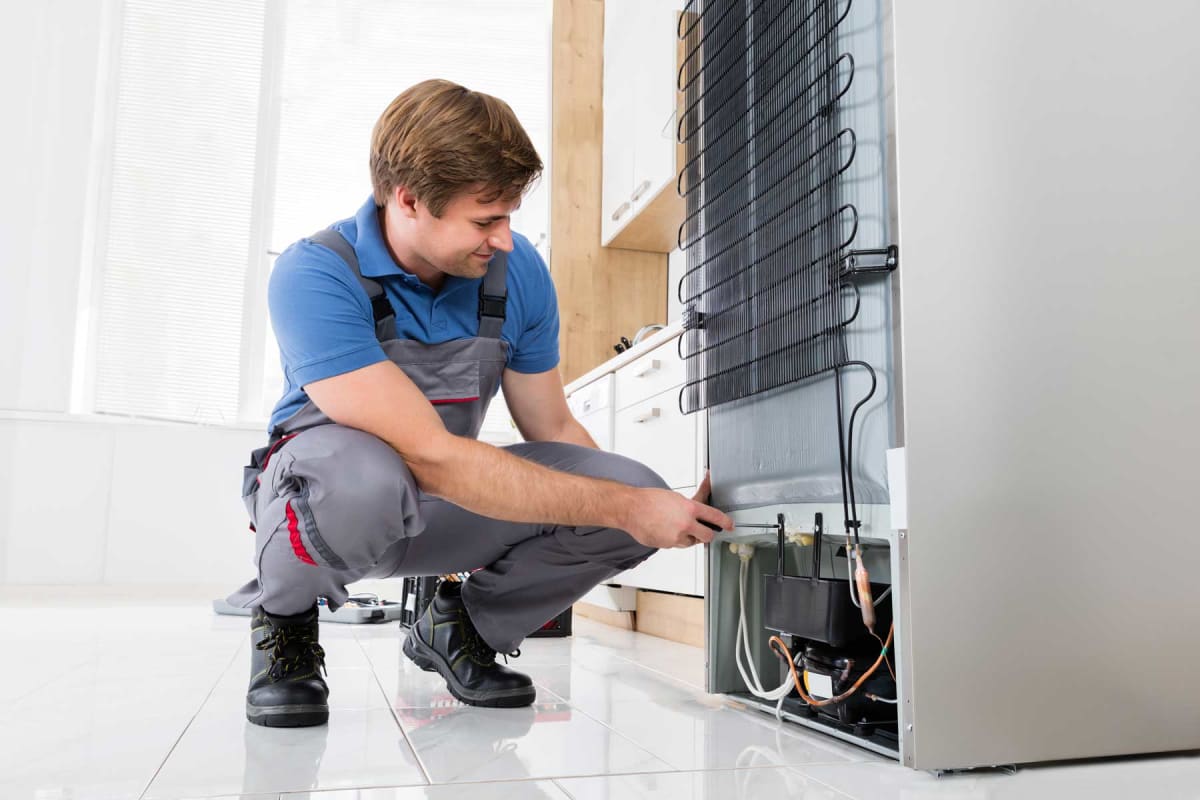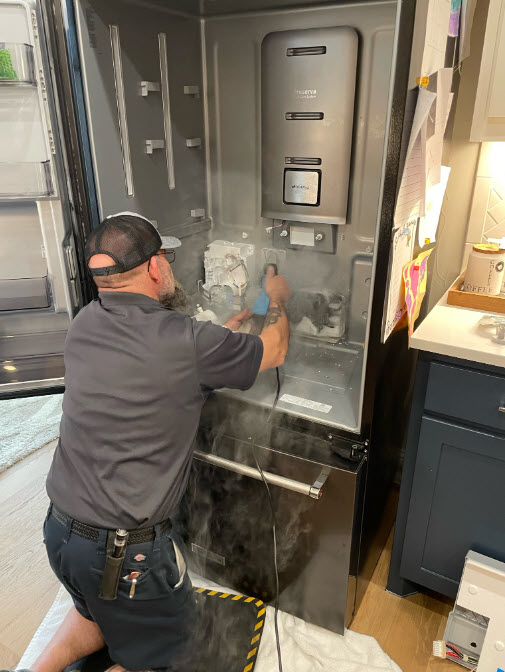Your Year-Round Appliance Maintenance Calendar Powered by Best Sub-Zero Service Near You Dependable Refrigeration & Appliance Repair Service
The Ultimate Guide to Do It Yourself Home Appliance Repair Work Techniques
When home appliances damage down, it's easy to really feel overwhelmed. Dependable Refrigeration Appliance SubZero repair near me. But with the ideal expertise and devices, you can take on typical concerns on your own. From refrigerators to dish washers, recognizing just how to troubleshoot and repair these devices can save you time and cash. Are you ready to discover necessary techniques that will empower you to take care of repair work with confidence? Allow's discover the vital areas where do it yourself skills can make a significant distinction.
Comprehending Typical Home Appliance Problems
When you count on your home devices, it can be discouraging when they all of a sudden quit working or act up. Comprehending usual device troubles can aid you repair concerns successfully. For example, if your refrigerator isn't cooling, check the temperature setups or evaluate the door seal for voids. A malfunctioning cleaning equipment could be as a result of a clogged up drainpipe filter or a damaged belt.
If your stove isn't home heating, faulty elements or thermostat problems might be to condemn,. Dish washers frequently experience problems with drain, so see to it the filter is clean and the drain tube isn't kinked.
Likewise, pay attention for unusual sounds; they typically indicate mechanical concerns. By acknowledging these indications, you can save time and possibly stay clear of expensive repair work. A little knowledge goes a long way in maintaining your home appliances, so remain notified to keep everything running efficiently.
Important Devices for DIY Repairs
Before diving into do it yourself appliance repairs, it is very important to gather the right tools to assure the process goes smoothly. Start with an excellent set of screwdrivers, including both flathead and Phillips, as they're essential for opening up most appliances. You'll likewise want a set of pliers for clutching and twisting cables or tiny parts.
Don't fail to remember a multimeter; it aids you test electric parts and detect issues efficiently. An outlet set is helpful for loosening up or tightening up screws, while an energy knife can be useful for reducing wires or opening packaging.
Lastly, take into consideration having a flashlight handy to brighten dark spaces inside your appliances. With these essential tools, you'll be fully equipped to take on various fixings, conserving both money and time. Collect your equipment and obtain prepared to roll up your sleeves!
Safety And Security First: Preventative Measures to Take
Prior to you begin any kind of appliance repair, it's crucial to prioritize safety and security. Ensure you put on personal protective devices, disconnect the power resource, and maintain your workspace organized. These basic preventative measures can aid stop mishaps and ensure a smoother fixing process.

Individual Safety Tools
Safety equipment is an important part of any type of do it yourself device repair project. You should constantly wear safety goggles to protect your eyes from dust and debris. A durable pair of gloves will protect your hands from harmful products and sharp sides. Think about making use of a mask if you're dealing with chemicals or dirt, ensuring you breathe securely while working. Steel-toed boots are additionally a clever selection, specifically when raising hefty home appliances. Don't fail to remember to put on lengthy sleeves and pants to safeguard your skin from prospective injuries. By prioritizing personal safety tools, you'll significantly decrease the risk of accidents and injuries. Bear in mind, being prepared with the ideal gear maintains you risk-free and focused on completing your fixing efficiently.
Source Of Power Interference
To assure a safe DIY home appliance repair, separating the power resource is important. This basic action protects against electric shocks and guarantees that you can concentrate on the repair without fretting regarding unexpected activation. As soon as you're certain that the power is separated, you can with confidence proceed with your repairs, understanding you have actually taken the essential preventative measures to shield on your own.
Workspace Organization
A well-organized job location can make all the difference in your DIY appliance repair service project. Beginning by removing your work area of mess to avoid accidents and diversions. A tidy room not only boosts efficiency but additionally keeps you secure while you work on your home appliance repair work.
Step-by-Step Overview for Refrigerator Fixes
When your refrigerator begins acting up, it can be aggravating, however taking on the problem yourself can save you time and money. Inspect for usual problems like temperature level fluctuations or unusual sounds. For a loud fridge, check the fan and verify it's not obstructed.
If there's water pooling inside, inspect the door seals for damage or dirt, and tidy them if needed. For ice build-up, clear the defrost drainpipe. Plug the fridge back in and monitor it for a couple of hours once you have actually attended to the problem. If the trouble persists, you may require to change a damaged component, like the compressor or follower motor. Keep in mind, do not think twice to seek advice from the handbook or seek specialist aid if needed.
Fixing Cleaning Maker Issues
Simply like refrigerators, cleaning makers can present their very own set of difficulties, yet numerous concerns can be resolved with a little troubleshooting. Initially, if your machine won't begin, check the power cord and confirm it's connected in. Next off, evaluate the door latch; a faulty latch can protect against the cycle from beginning. It may be due to international objects stuck in the drum or the drain pump. if you observe unusual sounds throughout procedure.
If your clothing aren't obtaining tidy, take into consideration the water degree and cleaning agent type; utilizing way too much cleaning agent can develop excess suds, influencing efficiency. For leakages, check out the tubes for splits or loosened links. Tightening up these can often solve the problem. Normal upkeep, like cleaning the filter, can stop several issues from arising. Keep in mind, a little troubleshooting goes a long way in maintaining your washing equipment running efficiently.
Troubleshooting Ovens and Cooktops
How can you repair usual concerns with your stove or cooktop? Begin by examining the power supply. Make sure it's connected in and the circuit breaker is not stumbled. If it's a gas cooktop, confirm the gas valve is open. Next off, test the heaters: if they don't ignite, cleanse the igniter and check for clogs in the heater ports.
If your stove isn't heating, inspect the temperature level setups and confirm the door seals you could check here snugly. A malfunctioning heating component might also be the culprit; you might need to change it if it's damaged.
For irregular cooking, revolve your pans and consider utilizing a stove thermostat to confirm accurate temperatures. If you listen to unusual noises or odor gas, transform off the device right away and consult a professional. By complying with these actions, you can identify and deal with lots of usual stove and range concerns efficiently.
Repairing Dishwashing Machines Facilitated
When your dish washer begins breaking down, it can be frustrating, yet addressing common problems isn't as difficult as it seems. You'll discover detailed troubleshooting approaches that will certainly assist you pinpoint the issue, in addition to the important tools you'll need to take on repair services on your own. Let's make fixing your dishwasher a breeze!
Common Dishwasher Problems
While dish washers are created to make your life less complicated, they can sometimes run into common issues that leave you feeling irritated. One regular issue is poor cleaning efficiency; this often takes place as a result of clogged spray arms or dirty filters. You could additionally observe water pooling near the bottom, which can indicate a malfunctioning drain or a kinked tube. It might be a basic concern with the latch device or door seal if your dish washer's door will not latch. In addition, odd noises can signify loosened parts or damaged elements. Lastly, if you smell something weird, it may be time to inspect for food debris or a malfunctioning electric motor. Resolving these problems early can save you time and hassle later on (Emergency Sub-Zero Repair Dependable Refrigeration & Appliance Repair Service).

Step-by-Step Troubleshooting
Before diving into fixings, it's important to identify the certain concern your dishwashing machine is dealing with. If your dishwashing machine won't begin, check the power supply and door latch. By systematically attending to each possible concern, you can determine the problem and take the necessary steps to repair it, making your dishwasher feature like brand-new once more.
Essential Repair Work Tools
When fixing your dish washer,Having the right devices at your disposal can make all the difference. Begin with a screwdriver set, as you'll frequently need both Phillips and flathead choices. A multimeter's vital for diagnosing electrical concerns, while pliers can assist you hold and manipulate numerous parts. Do not neglect a pail or towels for any type of water spills throughout repair services.
You could also want a degree to guarantee your dishwashing machine's correctly straightened. With these important tools, you'll be well-equipped to take on any dishwashing machine repair difficulty that comes your method.
Regularly Asked Questions
If a Home Appliance Is Well Worth Fixing?, just how Do I Identify.
To establish if a home appliance's worth repairing, consider its age, fixing costs, and present value. If fixings exceed half the replacement expense, you might want to purchase a brand-new design rather.
Can I Find Substitute Components In Your Area for My Home Appliance?
Yes, you can commonly locate substitute components in your area for your home appliance. Check hardware shops, device fixing shops, or neighborhood classifieds. Don't forget to bring the design number to guarantee you obtain the appropriate part!
When Repairing Appliances?, what Usual Mistakes Should I Avoid.
When repairing devices, prevent rushing via diagnostics, overlooking security precautions, or making use of inaccurate tools. Don't miss checking out manuals or learn this here now seeing tutorials; they supply necessary assistance. Hold your horses and comprehensive to assure successful fixings and protect against further damages.
How much time Does a Common Do It Yourself Home Appliance Repair Take?
A regular do it yourself home appliance repair normally takes one to three hours, relying on the complexity. You'll intend to gather your materials and tools initially, and follow directions very carefully to avoid unnecessary hold-ups.
Are There Any Kind Of Warranties for Do It Yourself Device Services?
When you deal with do it yourself appliance fixings, warranties typically don't cover your job. Some producers may recognize warranties for parts you replace. Constantly check your home appliance's service warranty terms prior to starting any type of repair services to stay clear of issues.
Before diving into YOURURL.com DIY home appliance repair services, it's vital to collect the right tools to guarantee the process goes smoothly.Before you start any home appliance repair service, it's essential to prioritize security.To ensure a risk-free Do it yourself home appliance repair service, disconnecting the power source is necessary.An efficient job location can make all the distinction in your Do it yourself device fixing task. Constantly check your home appliance's guarantee terms before starting any repairs to avoid issues.